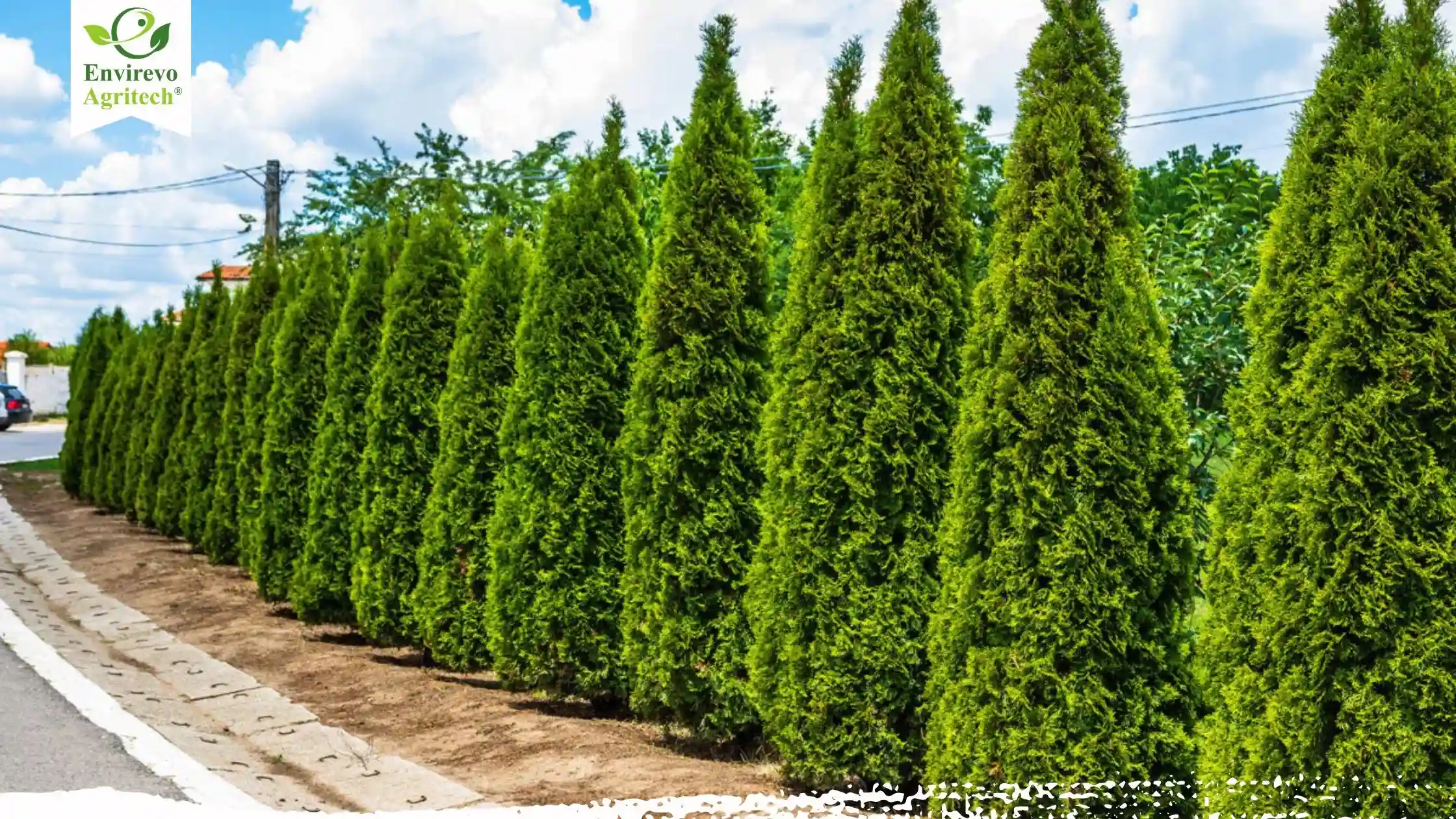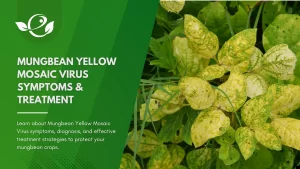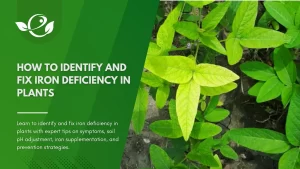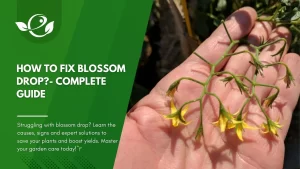Table of Contents
Arborvitae trees are the secret weapon of many gardeners and homeowners who want year-round greenery, privacy, and easy care. These hardy evergreens — famous for their rich green foliage and neat growth habit — can transform your landscape into a lush, private retreat. Whether you’re planting your first Arborvitae hedge or trying to fix browning issues, this comprehensive guide covers everything you need to know.
What is Arborvitae? (Overview)
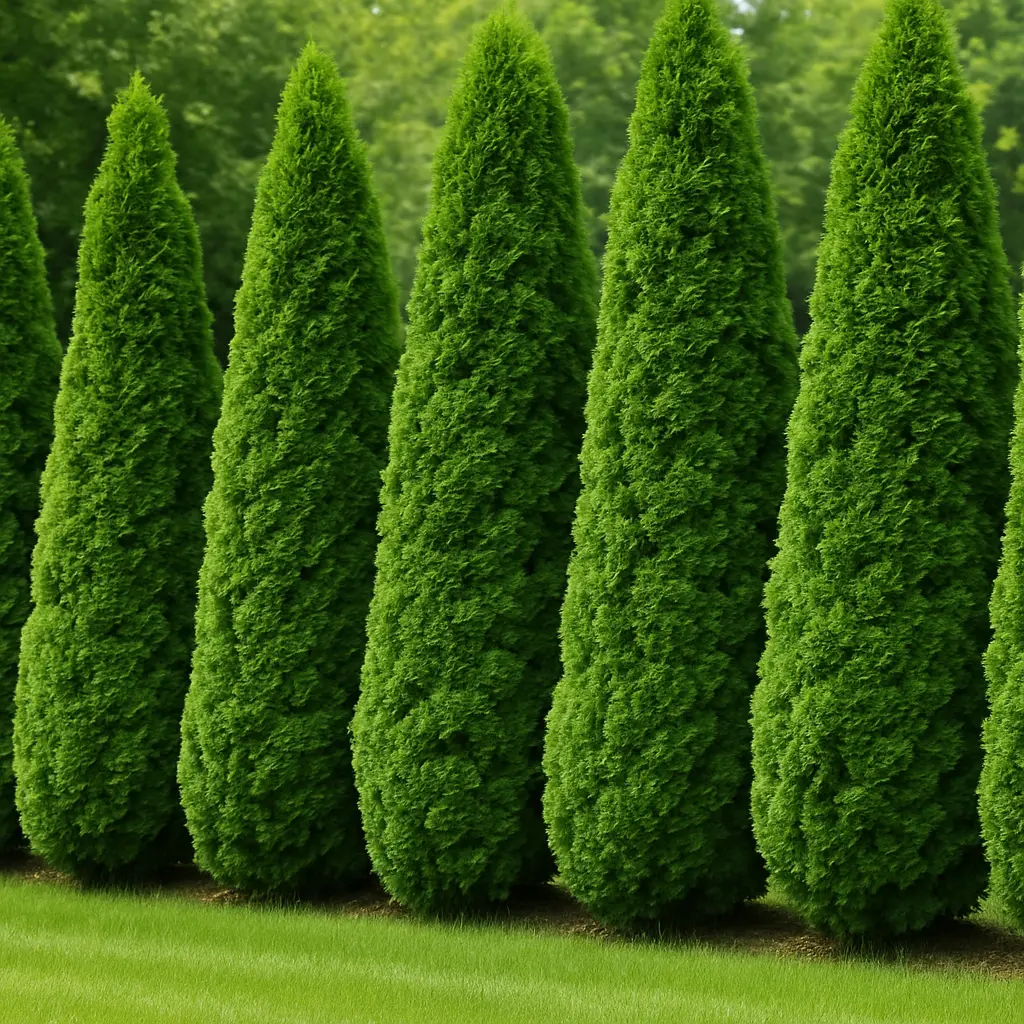
Arborvitae (Thuja species) are evergreen coniferous trees and shrubs native to North America and parts of Asia. Their name, meaning “tree of life,” reflects their enduring appeal in gardens and landscapes.
| Feature | Details |
|---|---|
| Common Name | Arborvitae, Northern White Cedar |
| Botanical Name | Thuja occidentalis, Thuja plicata, Thuja standishii |
| Plant Type | Evergreen coniferous tree/shrub |
| Hardiness Zones | USDA Zones 3-8 (varies by variety) |
| Sunlight | Full sun to partial shade (6+ hours ideal) |
| Soil Type | Well-drained, loamy, slightly acidic to neutral |
| Mature Size | 10-60 ft tall, 3-20 ft wide (variety dependent) |
| Growth Rate | Moderate to fast (1-3 ft per year) |
| Foliage Color | Green to dark green, some varieties golden |
| Special Features | Deer-resistant (some types), privacy screen, windbreak |
Popular Arborvitae Varieties
- Emerald Green Arborvitae: Among the most beloved is the Emerald Green Arborvitae (Thuja occidentalis ‘Smaragd’), prized for its rich green color that holds beautifully through winter. This variety grows in a narrow, upright form, reaching about 12 to 15 feet tall and 3 to 4 feet wide at maturity, making it ideal for tight spaces and formal hedges. Its slower growth rate also means less frequent pruning, which many homeowners appreciate.
- Green Giant Arborvitae: For those seeking fast-growing privacy screens, the Green Giant Arborvitae (Thuja standishii x plicata) is a standout. Known for its vigorous growth — up to 3 feet per year — Green Giant quickly forms towering walls of greenery, reaching heights of 30 to 50 feet when mature. Its tolerance for heat, humidity, and various soil conditions makes it a favorite in many parts of the U.S., especially where larger privacy barriers are needed.
- Techny Arborvitae: The Techny Arborvitae (Thuja occidentalis ‘Techny’) offers a balance between size and hardiness. It grows to about 15 to 20 feet tall with a full, broad pyramidal shape and is particularly noted for its excellent winter color retention and cold resistance. Techny is a top choice in northern climates where harsh winters can take a toll on other evergreens.
- Nigra Arborvitae: If you prefer a darker green tone and a slightly denser habit, the Nigra Arborvitae (Thuja occidentalis ‘Nigra’) is worth considering. This variety maintains a deep green hue all year and grows moderately fast, reaching up to 20 feet tall. Its fuller appearance makes it an excellent option for both privacy screens and ornamental plantings.
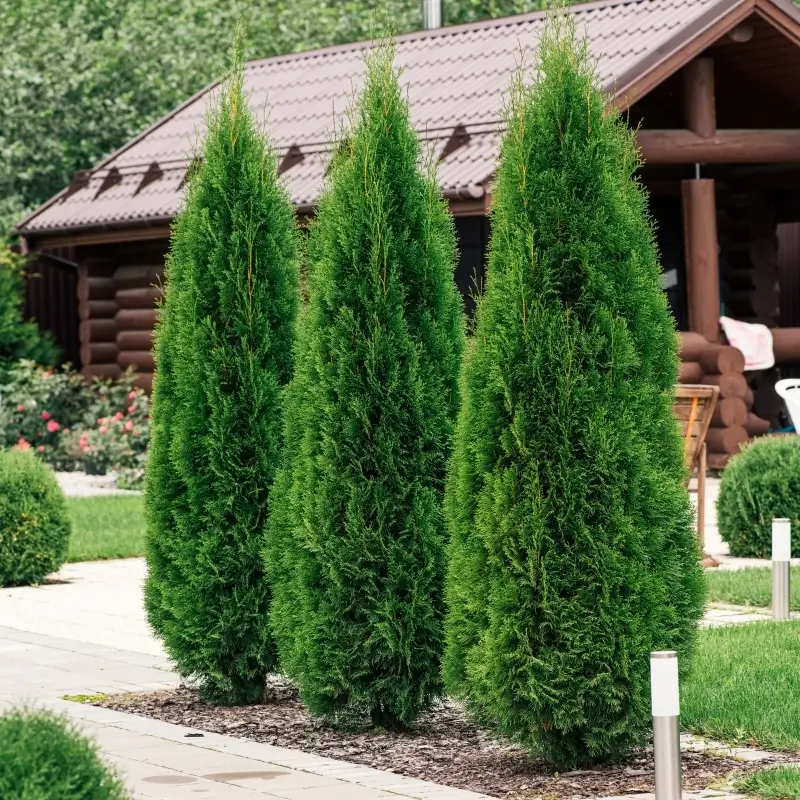
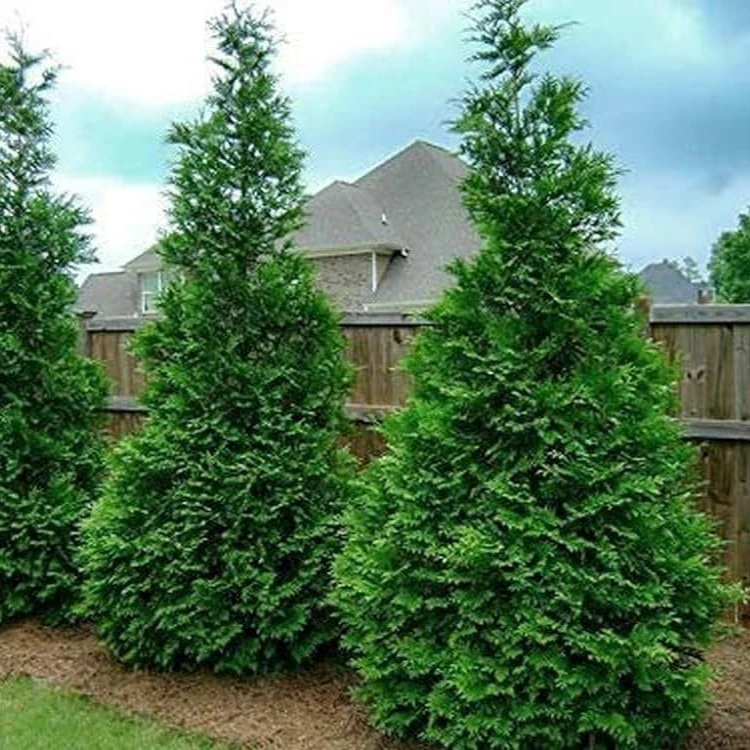
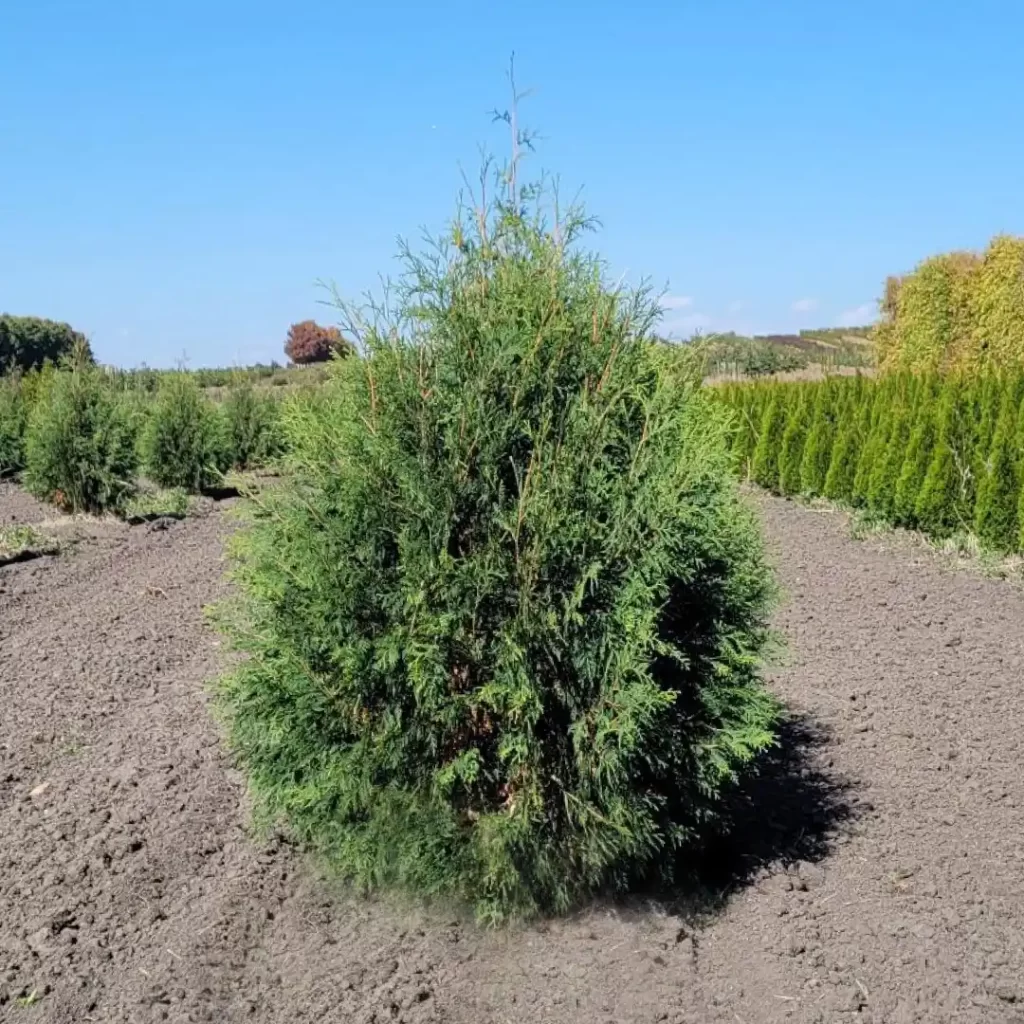
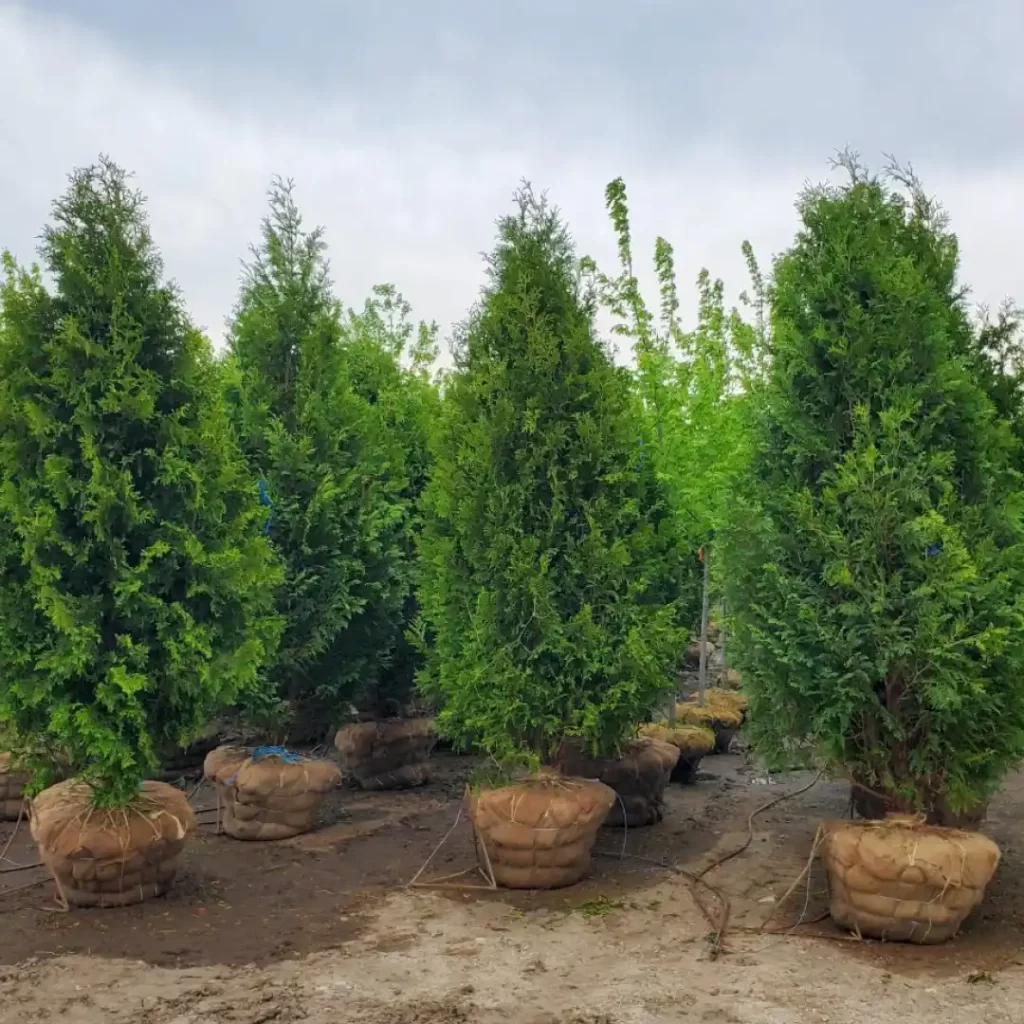
Benefits of Planting Arborvitae in Your Garden
- Natural Privacy Screen: Dense foliage blocks views and muffles sound.
- Low Maintenance: Minimal pruning and care once established.
- Year-Round Greenery: Evergreen leaves stay vibrant even in winter.
- Fast-Growing Options: Varieties like Green Giant can grow 3 feet per year.
- Wildlife Friendly: Shelter for birds without invasive root systems.
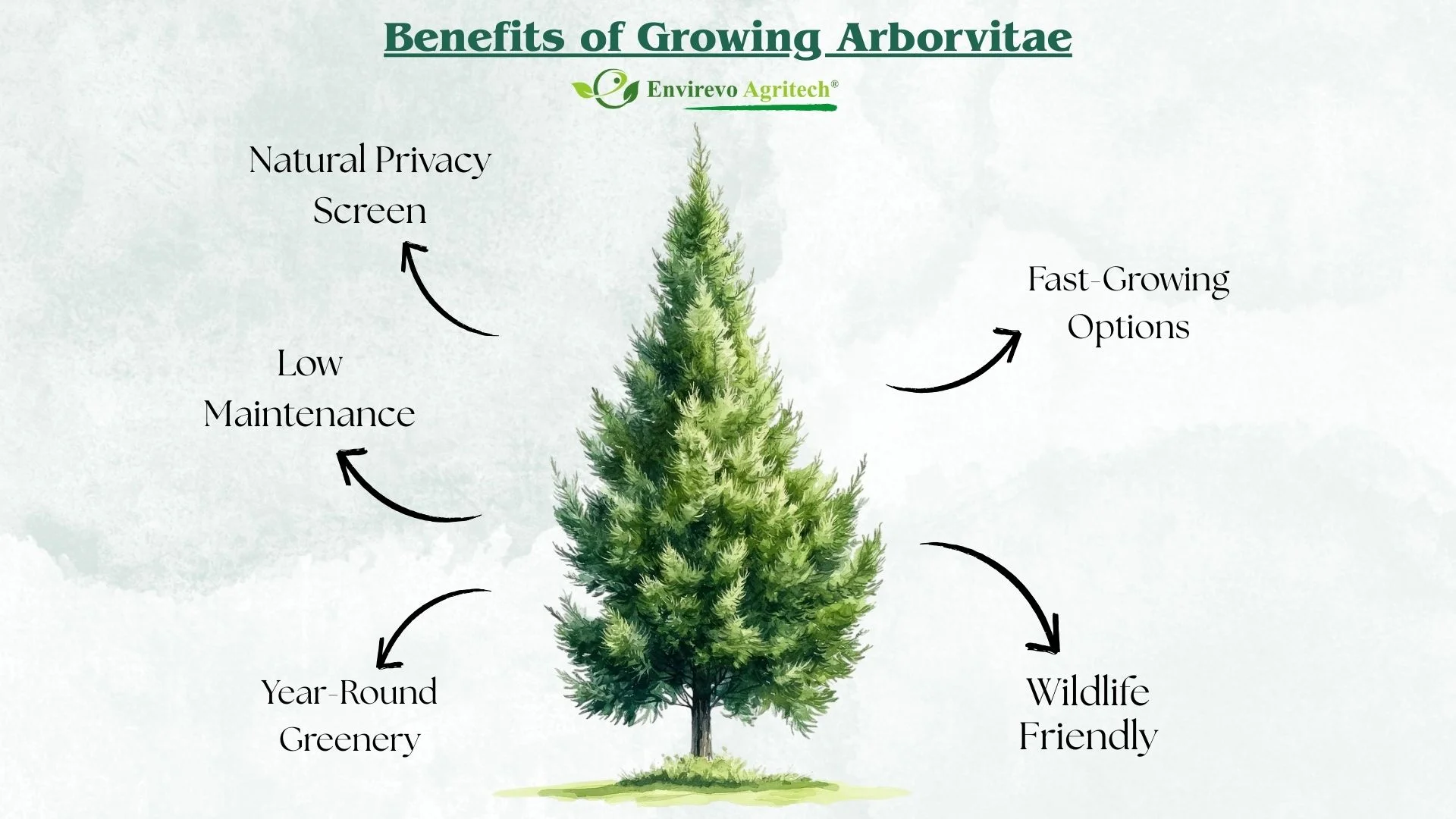
How to Plant Arborvitae: Step-By-Step Guide
Best Time to Plant Arborvitae
- For the best results, plant Arborvitae in early spring or early fall. This timing allows roots to establish before extreme summer heat or winter cold.
Choosing the Right Location
- Sunlight: Arborvitae thrives in full sun (6+ hours/day) but tolerates partial shade.
- Soil: Prefers well-drained, slightly acidic to neutral soil. Avoid heavy clay or constantly wet areas.
- Drainage: Waterlogged roots cause root rot — choose a spot with good drainage.
Spacing Tips for Arborvitae Hedges
- For Emerald Green Arborvitae: space 3-4 feet apart.
- For Green Giant Arborvitae: space 5-6 feet apart.
Proper spacing ensures airflow, reducing disease risk and allowing plants to reach mature width.
Planting Instructions
- Dig the Hole: Twice as wide as the root ball, no deeper than the root crown.
- Amend the Soil: Mix in compost if soil is poor but avoid heavy fertilization at planting.
- Place and Backfill: Set the tree at ground level, backfill gently, and tamp lightly.
- Water Thoroughly: Soak the soil immediately after planting.
- Mulch: Apply a 2-3 inch layer around the base, keeping mulch away from the trunk.
Arborvitae Care Tips for Healthy Growth
Watering Schedule for Arborvitae
- First Year: Water deeply 1-2 times per week.
- Established Trees: Water during droughts but avoid constant soggy soil.
Tip: Check soil moisture 2-3 inches deep before watering.
Fertilizing Arborvitae: Do’s and Don’ts
- Use a balanced, slow-release evergreen fertilizer in early spring.
- Avoid over-fertilizing, which can cause excessive, weak growth.
- Skip fertilization in late summer to prevent tender new shoots vulnerable to frost.
Mulching Tips
- Keep mulch 2-3 inches thick to conserve moisture and prevent weeds.
- Avoid piling mulch against the trunk (mulch volcanoes cause rot).
Winter Care for Arborvitae
- Snow Protection: Gently brush off heavy snow to prevent branch breakage.
- Wind Protection: Wrap young plants with burlap in exposed locations.
- Anti-Desiccant Spray: Apply in late fall to reduce winter moisture loss.
How to Prune Arborvitae Like a Pro
When is the Best Time to Prune Arborvitae?
- Late spring to early summer is ideal after new growth emerges.
- Avoid pruning in late summer or fall, as this stimulates new growth vulnerable to frost.
Tools You’ll Need
- Hand pruners for small branches
- Loppers for thicker limbs
- Hedge trimmers for shaping hedges
Step-By-Step Pruning Instructions
- Remove Dead or Diseased Wood first.
- Shape Lightly: Trim the tips to maintain size and encourage dense growth.
- Avoid Cutting into Old Wood: Arborvitae doesn’t regrow from bare brown wood.
How to Thicken Arborvitae Hedges
- Lightly prune the outer foliage in early summer.
- Consistent light trimming encourages bushier, thicker growth over time.

Troubleshooting Common Arborvitae Problems
Why Is My Arborvitae Turning Brown?
- Drought stress: Underwatering leads to browning tips.
- Winter burn: Cold wind and sun cause foliage dehydration.
- Pests: Spider mites and bagworms can damage foliage.
- Diseases: Root rot or fungal blight.
Common Arborvitae Diseases
- Root Rot: Caused by poorly drained soil.
- Cankers: Sunken lesions on branches leading to dieback.
- Needle Blight: Fungal disease causing brown patches.
Arborvitae Pest Problems
- Bagworms: Create silken bags and defoliate trees.
- Spider Mites: Cause stippled, dull foliage.
- Scale Insects: Sap feeders that weaken trees.
Solutions and Treatment Tips
- Bagworms: Handpick bags in winter; use Bacillus thuringiensis in early summer.
- Spider Mites: Spray with insecticidal soap or horticultural oil.
- Fungal Diseases: Improve drainage and apply fungicides when necessary.
Common Pests & Diseases
| Pest/Disease | Common Cause | Signs to Look For |
|---|---|---|
| Bagworms | Caterpillars that build silken bags on branches | Brown, bag-like structures hanging from branches; defoliation and thinning foliage |
| Spider Mites | Hot, dry conditions and overcrowding | Yellowing or bronzing of needles; fine webbing visible on close inspection |
| Scale Insects (Arborvitae Scale) | Sap-sucking insects on stems and needles | Yellow spots on needles, premature needle drop, and visible tiny, armored scales |
| Deer Browsing | Heavy deer populations during winter | Ragged, chewed branch tips and stripped lower foliage |
| Phytophthora Root Rot | Poor drainage and overly wet soil | Wilting, stunted growth, browning from the bottom up, and blackened roots |
| Cercospora Blight | High humidity and poor air circulation | Brown spots and needle drop starting from the lower branches upward |
| Kabatina Blight | Spring wetness and plant stress | Yellow tips turning brown, with small black fruiting bodies at needle bases |
| Winter Burn | Cold winds and frozen soil preventing water uptake | Browning of foliage, especially on the south/southwest sides in late winter |
| Juniper Tip Blight (Phomopsis) | Fungal disease spread by splashing water | Browning of shoot tips, resin droplets, and dieback of young shoots |
Conclusion: Grow Your Best Arborvitae Yet!
With their year-round greenery, easy care, and natural elegance, Arborvitae trees and shrubs are a fantastic addition to almost any landscape. Whether you’re crafting a lush privacy screen, adding structure to your garden, or simply enjoying their timeless beauty, success comes down to a few simple steps: proper planting, mindful pruning, and early troubleshooting.
By choosing the right variety and giving your Arborvitae the attention it deserves—especially when it comes to watering, spacing, and pest prevention—you’ll enjoy healthy, vibrant trees that thrive for years to come. So, roll up your sleeves and give your Arborvitae the care it needs today—your future green sanctuary will thank you!
Frequently Asked Questions (FAQ)
How far apart should I plant Arborvitae for a privacy screen?
For most varieties like Emerald Green, plant them 3 to 4 feet apart for a dense screen. Larger types like Green Giant should be spaced 5 to 6 feet apart to allow room for mature width.
Can I grow Arborvitae in containers?
Yes, compact varieties like Holmstrup or dwarf Emerald Green can be grown in large containers. Use well-draining soil and ensure the pot is deep enough for the roots.
How often should I fertilize my Arborvitae?
Fertilize once in early spring using a balanced, slow-release fertilizer designed for evergreens. Avoid over-fertilizing, as it can stress the plant.
Why is my Arborvitae turning brown in the center?
This is often normal seasonal needle drop, but if excessive, it could signal poor air circulation, drought stress, or root issues. Check soil moisture and avoid overcrowding.
Is Arborvitae safe for pets?
While not highly toxic, Arborvitae contains compounds that can cause mild stomach upset if ingested by pets. It’s best to discourage chewing or consumption.
Do Arborvitae trees attract wildlife?
Yes, birds often nest in dense Arborvitae hedges, and some small animals may use them for shelter. However, deer may browse on certain varieties during harsh winters.
How long does it take for Arborvitae to reach full size?
Growth rate depends on the variety. Green Giant can reach 30 feet in 10-15 years, while slower growers like Emerald Green may take 15-20 years to mature.
